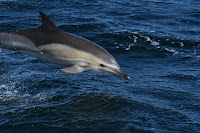
In the early hours of the morning, I and a group of around fifty, boarded the Atlantic Star in Cape May, New Jersey. The trip was organized by
See Life Paulagics, which offers pelagic birding trips at different times and at different locations throughout the year. The term pelagic refers to the open ocean, far from the coast and in deep water. Certain bird species specialize in living for most of the year out in the pelagic zone. It was my hope to see at least a few species I had never seen before and this trip didn't disappoint. You may be asking yourself about now, what does this have to do with Taking Out the Trash in Eastern Pennsylvania. The answer is very simple. Even in Pennsylvania we can have an impact on our oceans and the wildlife that lives in them. In Eastern PA the majority of streams and rivers are within the Delaware Watershed. This means any litter in these waterways has the potential to flow down stream to the Delaware and out to the ocean through the Delaware Bay. The actions we take, either good or bad, can have an effect on wildlife that most of us aren't even aware of. With this post I want to share with you the wildlife that I had the opportunity to see on this trip. These species can be added to the reasons why I do the clean-ups. I hope you enjoy these photos and this post. Above is a Great Cormorant that we passed as we exited out to the sea through the jetties.

Not long after leaving the land behind the sun broke through the horizon and offered us a stunning sight. What a way to start a winter morning!
Northern Gannets were one of the first species spotted flying over the water. It is also a species that is affected by trash. Northern Gannets collect and use trash in the building of their nests. This can lead to the death of both adults and young that get entangled in items like netting. In North America the only places that this species nest are in Quebec and Newfoundland. You can sometimes see Gannets from the beach, but for a closer look you either have to head far up north or out to sea.
This Greater Black-backed Gull was coming in for some chum at the back of the boat. I have seen this species many times in Pennsylvania. To me its adaptability is pretty amazing. They can survive just as well on the open ocean as the do on the coast or even on a landfill.
An Iceland Gull spent a good amount of time flying around the back of the boat. This was one of the new species for me! Iceland Gulls can show up inland as well and can sometimes be spotted mixed in with the more common gulls on landfills. In addition to this Iceland and the common gulls, I did see Bonaparte's Gulls and a Black-legged Kittiwake. Even though they were really close I failed to get good photos of those two species. Still really cool to see.
Short-beaked Common Dolphins were spotted on several occasions throughout the day and in large numbers. Some swam right along the boat and others gave us a show breaching out of the water.
With the naked eye this large cargo vessel just looked like a speck on the horizon. Look at all those cargo containers. Seeing it made me wonder if any of the recyclables I collected over the years were on it and making their way to China. A lot of our recyclables are packaged and shipped this way to other countries where they are processed and turned into new products.
I think this one is an oil tanker and was the only other large ship that I remember us passing. There were smaller fishing vessels, but in all not a lot of traffic on the water.
For me this was the best bird of the trip! A Common Murre. The guides were great at spotting and pointing out the different species and I still don't know how they were able to see this in the choppy water. I did also get to see more than a few Dovekie, a species I really wanted to check off my list. However, they were in flight and I was unable to get any good shots of them. I also missed a Puffin that like this Murre was just sitting on the water.
In this series of shots you can see how a Northern Gannet dives into the water. According to the Cornell Lab of Ornithology, when a Northern Gannet dives they can go as deep as 72 feet! That is pretty impressive. If you want to learn more about the birds in this post I would recommend checking out Cornell's website
allaboutbirds.org.
This series of photos also shows how the common gulls behave when chum is being thrown out. They gather in a flock towards the back of the boat, go after a piece and when they get one, often will sit on the water for a short time before rejoining the flock following the boat.
Just as beautiful as the sunrise that started the day, this sunset finished it as we were nearing land. I had a great day on the water and I hope you enjoyed the photos in this post. The next post is going to be pretty trashy.
If you would like to know more about pelagic trips please visit
paulagics.com The trips are fun, the people all enjoy birds and the guides are fantastic! Also, the species diversity changes with the seasons, the trip listings show you what could possibly be seen on them.





























































